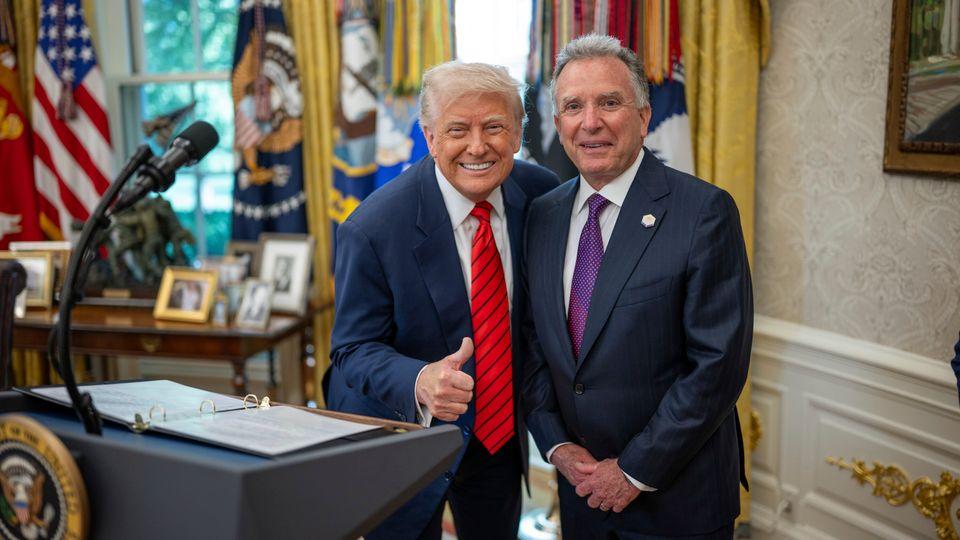Former President Donald Trump expressed cautious optimism about the prospects for peace between Russia and Ukraine, stating that he believes “we have a shot at” ending the ongoing conflict. Speaking to reporters, Trump highlighted potential diplomatic avenues and urged renewed negotiations, amid continued international efforts to resolve the war that has reshaped global geopolitics. His remarks add a new dimension to the discourse surrounding the conflict, drawing attention to the role of former U.S. leadership in discussions about Eastern Europe’s security crisis.
Trump expresses optimism on achieving peace between Russia and Ukraine
Former President Donald Trump shared a cautiously optimistic view regarding the ongoing conflict between Russia and Ukraine, suggesting that diplomatic efforts might soon bear fruit. During a recent interview, Trump emphasized the possibility of achieving peace, stating that “we have a shot at it.” His comments come amid heightened international tension and ongoing negotiations, highlighting his belief in the potential for a breakthrough despite the complex geopolitical landscape.
According to Trump, several factors could contribute to a peaceful resolution, including:
- Increased diplomatic engagement between key stakeholders
- Pressure from global economic sanctions
- Mutual interest in ending the humanitarian crisis
| Factor | Potential Impact |
|---|---|
| Diplomatic Talks | Facilitating communication channels |
| Economic Sanctions | Increasing leverage on Russia |
| Humanitarian Concerns | Encouraging ceasefire negotiations |
Analyzing the challenges and opportunities in current diplomatic efforts
Diplomatic initiatives aimed at resolving the conflict between Russia and Ukraine face a complex landscape defined by entrenched political interests and geopolitical tension. While optimism like former President Trump’s assertion of “having a shot at peace” injects hope, the reality involves navigating a maze of competing agendas. Key challenges include mistrust between the parties, the ongoing military engagements, and external influences that complicate direct dialogue. Effective diplomacy must therefore balance pressure with incentives, acknowledging the deep-rooted historical grievances and contemporary security concerns both sides harbor.
Despite these hurdles, unprecedented opportunities have emerged through multilateral platforms and increased global attention on the conflict’s humanitarian costs. The current climate allows for frameworks that incorporate:
- Enhanced communication lines backed by neutral mediators.
- Incremental ceasefires as confidence-building measures.
- International support conditioned on adherence to agreed terms.
| Diplomatic Factor | Challenge | Opportunity |
|---|---|---|
| Trust | Deep skepticism from historical conflicts | Neutral mediators fostering dialogue |
| Military Activity | Ongoing clashes undermining negotiations | Ceasefire agreements enabling talks |
| International Pressure | Varied global interests slowing consensus | Unified sanctions pushing towards peace |
Recommendations for US policymakers to leverage negotiation openings
US policymakers stand at a critical juncture where strategic engagement could break the current deadlock in the Russia-Ukraine conflict. To capitalize on the perceived diplomatic openings, it is essential to prioritize back-channel dialogues that facilitate candid discussions without public scrutiny, minimizing political pressure on all parties. This approach could build mutual trust, setting the stage for formal negotiations that address core security concerns. Additionally, leveraging international partners to craft a united front may amplify diplomatic sway, encouraging concessions and compromise from both sides.
Moreover, targeted economic measures should be calibrated to serve as negotiation incentives rather than punitive tools that entrench hostility. The US can deploy a mix of conditional sanctions relief and humanitarian aid pledges, contingent on progress towards ceasefire agreements. Below is a snapshot of strategic levers policymakers might consider:
| Diplomatic Tool | Purpose | Expected Outcome |
|---|---|---|
| Back-Channel Negotiations | Build trust discreetly | De-escalation pathways |
| Unified International Pressure | Strengthen bargaining position | Concessions from conflicting parties |
| Conditional Sanctions Relief | Incentivize negotiations | Progress towards ceasefire commitments |
